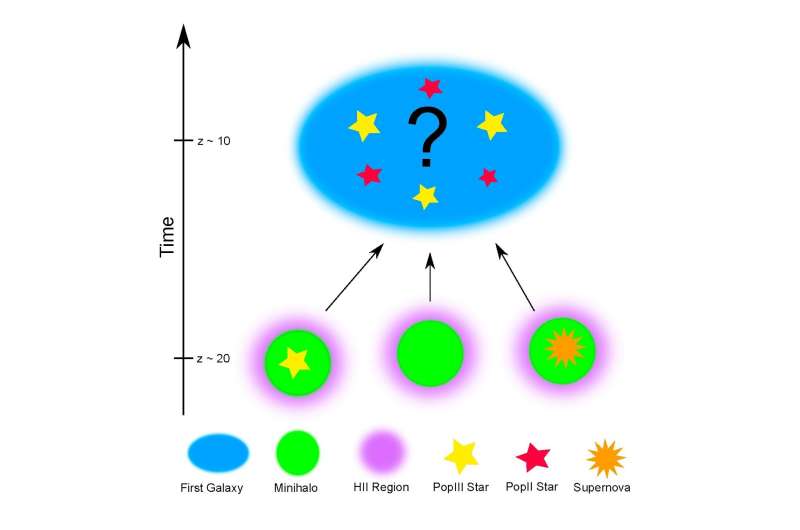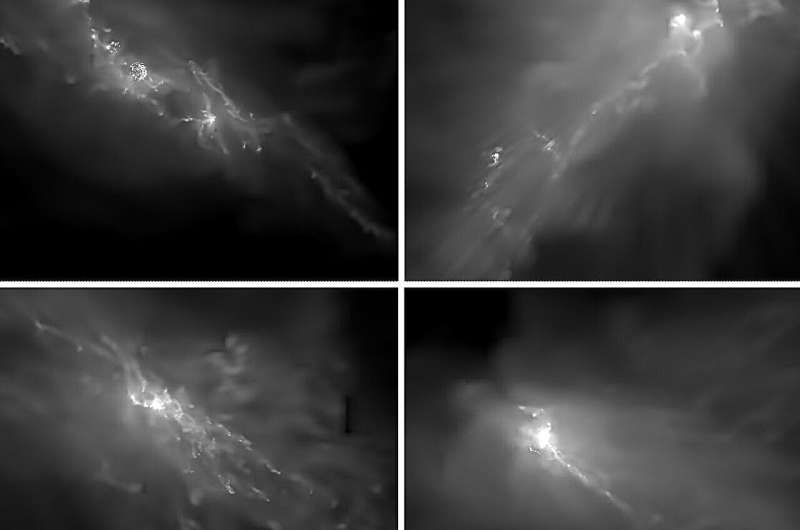Utilizing high-resolution three-dimensional radiation hydrodynamics simulations and a detailed supernova physics model run on supercomputers, a research team led by Dr. Ke-Jung Chen from the Institute of Astronomy and Astrophysics, Academia Sinica (ASIAA) has revealed that the physical properties of the first galaxies are critically determined by the masses of the first stars. Their study is published in The Astrophysical Journal.
The cosmic dawn is envisioned to have commenced approximately 200–400 million years after the Big Bang, marking the end of the cosmic dark ages with the illumination from the first stars (Pop III stars) and galaxies. Based on modern cosmology, the hierarchical assembly of dark matter (DM) halos provides gravitational wells that facilitate the formation of primordial gases, giving rise to the birth of the first stars within mini DM halos with masses of about 1 million solar masses.
Following the emergence of the first stars, the injection of radiation, metals, and mass from these stars and their supernovae triggers a transformative process, evolving the simple early universe into a state of increasing complexity. The cosmic dawn symbolizes the second phase transition after the Big Bang. Yet, the crucial transition from individual first stars to the formation of the first galaxies remains a central puzzle in modern astrophysics.
When DM halos reach masses of about 1 billion solar masses through the hierarchical assembly of structure formation, they become massive enough to sustain successive cycles of stellar birth and explosion. This marks the emergence of the first galaxies, as they can maintain star formation without losing all the fuel to the intergalactic medium.

The formation of these first galaxies is not only influenced by the evolution of DM but also by the daunting gas physics. Complex chemical, radiative, and mechanical feedback from the first stars and their supernovae played a crucial role in shaping the stellar populations in the first galaxies.
Addressing this significant problem, Dr. Ke-Jung Chen led the explosion group in utilizing powerful supercomputers to conduct high-resolution 3D radiation-hydrodynamics simulations, incorporating detailed supernova physics to model the formation of the first galaxies.
Their results reveal that the physical properties of the first galaxies are determined by the masses of the first stars. Supernovae from massive first stars produce more metals, influencing the primordial gas by cooling it and enabling the formation of low-mass stars.

In contrast to the grand spiral structure of our Milky Way, these first galaxies exhibit irregular shapes without rotational support. Within their central regions, a few hundred to a few thousand second-generation stars (Pop II stars) can form. The metallicity of the gas in the first galaxies has been enriched to about 0.01 solar metallicity.
The simulations also suggest that the first stars were not a predominant component of most first galaxies, as gas in massive halos was typically polluted by metals from other Pop III supernovae during hierarchical assembly before collapsing into pristine stars.
These first galaxies are considered the landmark of the cosmic dawn, and their direct detection in the universe is a significant goal for the James Webb Space Telescope (JWST) and upcoming 30-meter-class ground-based telescopes. This finding provides a bridge between the demise of the first stars and the emergence of the first galaxies, offering valuable insights into the physics of the cosmic dawn.
More information:
Ke-Jung Chen et al, How Population III Supernovae Determined the Properties of the First Galaxies, The Astrophysical Journal (2024). DOI: 10.3847/1538-4357/ad2684
Citation:
Unveiling the formation of the first galaxies (2024, March 21)
retrieved 21 March 2024
from
This document is subject to copyright. Apart from any fair dealing for the purpose of private study or research, no
part may be reproduced without the written permission. The content is provided for information purposes only.